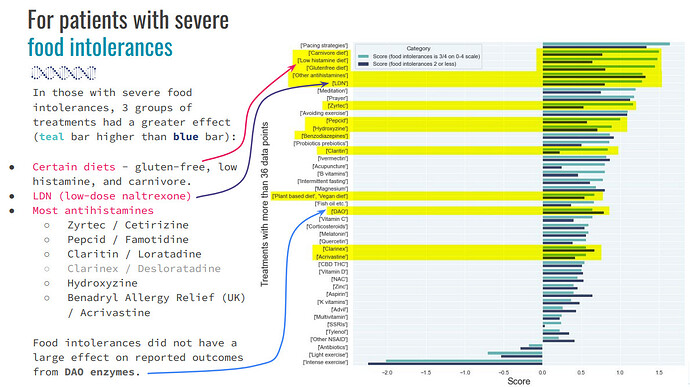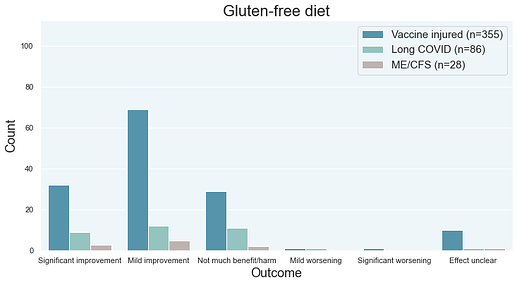Why eat gluten-free
Some people feel that eating gluten-free improves their symptoms. This is a top 5 treatment for patients with severe food intolerances.
If you have severe food intolerances (or allergies), you are more likely to benefit from this diet than people with milder or no food intolerances. See the Nov data-driven video for data.
This is one of the few treatments that is quite safe; most treatments aren’t.
How-to
Go to the gluten-free section of the supermarket
Obviously, this makes it very easy to find gluten-free items. Some supermarkets like Trader Joe’s and Whole Foods are much better at gluten labelling and having large gluten-free sections than other supermarkets. Costco is ok.
Be careful about bread - you may not like a lot of it. You can just buy the minimum amount so that you don’t end up with gluten-free bread that you don’t like.
The downside to shopping in the gluten-free section is that it can get expensive. So here are some ways to save time and money…
Meat and fruit
Steak, ?bacon?, and eggs are gluten-free. Fruit and its convenient version (juice) is gluten-free. You can eat these foods as staples without getting sick of eating the same thing over and over. (I speak from experience.)
To save money on meat, here are some ideas:
- Pork and chicken instead of beef.
- Tougher cuts like blade steak, the shoulder cuts, brisket, duck wing, lamb head, shank, stewing/old chicken, etc. Some of the really tough cuts need to be slow-cooked… bake it at low temperature for several hours, braise, sous vide, smoker, pressure cooker, boil it for several hours (or use a thermos cooker), etc. Recipe sites like AllRecipes.com can teach you how to cook.
- Off cuts like heart. Heart is like a muscle meet. Some butchers will give you fat trimmings for free.
- A little bit of liver can be very cheap and filling. However, you can’t eat too much of it.
Normal supermarket foods
Some of these are gluten-free. However, you will need to carefully read the packaging which can be VERY annoying.
Here’s how to read the packaging:
-
Look for the words gluten-free on the packaging. If it says that, then you’re done.
-
Flip to the back and see if there is a section which says "Contains: " or "May contain: ". Make sure it doesn’t say wheat in there.
-
Then look at the ingredients. You’ll have to look for wheat, soy sauce (usually made from wheat), most grains (which may be contaminated even if the grain is gluten free), etc. This can get tiresome and you will probably make mistakes in the beginning.
If you eat meat and fruit without any grains or vegetables, you can be lazy and avoid all of this.
So what can you eat?
Here are some ideas for entrees… you’re basically dealing with potato, grain, rice, or corn:
- Mashed potatoes (pre-made or cook it yourself).
- Shepherd’s pie.
- Hash browns
- Gluten-free pasta
- Rice, rice noodle, Pho (vietnamese noodle)
- Corn, corn-based Mexican food (tacos, nachos, etc.)
Also:
- Most cheeses
- Most sausages
- Most processed meats like salami
- Sushi, but usually it’s suspicious because it may contain gluten. You’ll need to buy gluten-free soy sauce.
- Sashimi
Junk food:
- Vanilla ice cream
- Soda
- Some candies
- Most chocolate
- Some chips
How to eat out
Most big chain restaurants like McDonald’s, steakhouse chains, etc. will have a menu that lists your gluten-free choices. Just Google it, e.g. mcdonald’s gluten free menu. Either you’ll find the official menu or an unofficial menu with a convenient breakdown of gluten-free choices.
Stay away from Chinese restaurants- they are pretty much a wasteland when it comes to gluten-free eating.
- Vietnamese restaurants are good because of pho.
- Japanese restaurants are good because of sashimi, though you’ll want to bring gluten-free soy sauce. Either pour some into a small container or buy packets (online?).
For those who are highly sensitive to gluten…
If you benefit from eating gluten-free, you may discover that you can react to traces of gluten. These traces are gluten are everywhere:
- Food marked as gluten-free. (Yes, some of it is a lie.)
- Gluten-free grains that were processed on equipment that handled gluten.
- Utensils used to cook the food.
- Cross-contamination at restaurants.
The guide below deals with that situation. I wouldn’t worry too much about this in the beginning. You can experiment with a stricter diet later on.
What to do if this doesn’t help
Most people will not have an incredible response to a gluten-free diet. Only a minority of people report significant improvement from eating gluten-free.
So if that happens to you, you can also try other solid diet options such as low histamine and carnivore. The data does show that you may respond better to other diets.
Carnivore has more risk than gluten-free and low histamine so please do your research on it before starting.
I hope this helps.




